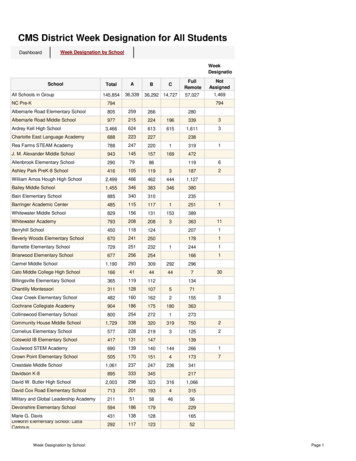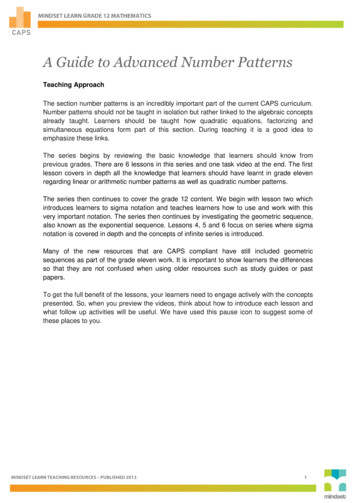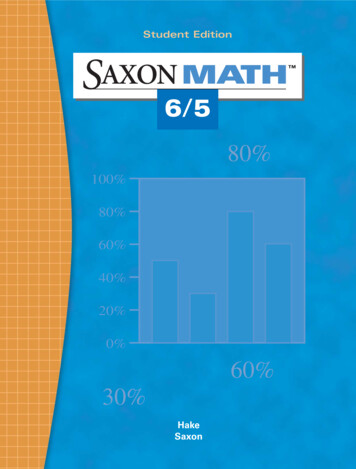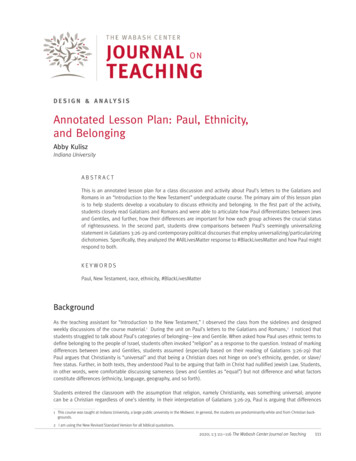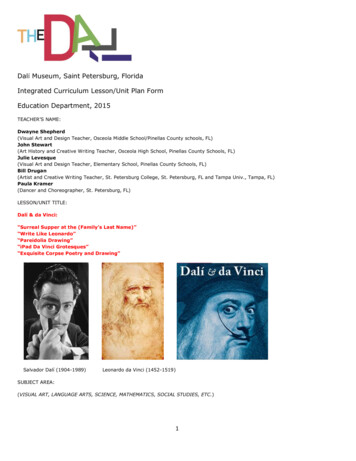
Transcription
Dalí Museum, Saint Petersburg, FloridaIntegrated Curriculum Lesson/Unit Plan FormEducation Department, 2015TEACHER’S NAME:Dwayne Shepherd(Visual Art and Design Teacher, Osceola Middle School/Pinellas County schools, FL)John Stewart(Art History and Creative Writing Teacher, Osceola High School, Pinellas County Schools, FL)Julie Levesque(Visual Art and Design Teacher, Elementary School, Pinellas County Schools, FL)Bill Drugan(Artist and Creative Writing Teacher, St. Petersburg College, St. Petersburg, FL and Tampa Univ., Tampa, FL)Paula Kramer(Dancer and Choreographer, St. Petersburg, FL)LESSON/UNIT TITLE:Dalí & da Vinci:“Surreal Supper at the (Family’s Last Name)”“Write Like Leonardo”“Pareidolia Drawing”“iPad Da Vinci Grotesques”“Exquisite Corpse Poetry and Drawing”Salvador Dalí (1904-1989)Leonardo da Vinci (1452-1519)SUBJECT AREA:(VISUAL ART, LANGUAGE ARTS, SCIENCE, MATHEMATICS, SOCIAL STUDIES, ETC.)1
Coordinate with the current Dalí Museum Exhibiton “Dalí & da Vinci: Minds, Machines and Masterpieces”:1. Science, 2. Masterworks, 3. Psychology, 4. Mathematics, 5. Invention.GRADE LEVEL(S):Grades: 6-8DURATION: (NUMBER OF SESSIONS, LENGTH OF SESSION)Monday through Friday: 9:30 am – 3:30 pm.Four to Five Sessions (60 to 120 minutes each daily) concentrating on art production.Total Unit consists of four to five sessions, each taught by one teacher and supported by all to create one final piece ofquality artwork per student.Each student also researches one Dalí painting and demonstrates their knowledge by giving multiple Junior Docentgallery tours on the final day of camp.Resources: (Books, Links, Films and Information)Books: The Dalí Museum Collection: Oil Paintings, Objects and Works on Paper.The Dalí Museum: Museum Guide.The Dalí Museum: Building Gardens Guide.Leonardo da Vinci for kids, His Life and Ideas, 21 Activities, Janis Herbert, Chicago Review Press, 1998. (Noting 22additional resources)Links: Films: Florida Art Education Association:www.faea.orgNational Art Education Association: www.arteducators.orgNational Core Art Standards:www.nationalartstandards.orgAnchor Standard #1. Generate and conceptualize artistic ideas and work.Anchor Standard #2. Organize and develop artistic ideas and work.Anchor Standard #3. Refine and complete artistic work.Anchor Standard #4. Analyze, interpret, and select artistic work for presentation.Anchor Standard #5. Develop and refine artistic work for presentation.Anchor Standard #6. Convey meaning through the presentation of artistic work.Anchor Standard #7. Perceive and analyze artistic work.Anchor Standard #8. Interpret intent and meaning in artistic work.Anchor Standard #9. Apply criteria to evaluate artistic work.Anchor Standard #10. Synthesize and relate knowledge and personal experiences to make art.Anchor Standard #11. Relate artistic ideas and works with societal, cultural and historical context todeepen g/education/resources.phpDalí Condensed: 5 lecture series, Peter Tush, Curator of Education, Dali Museum You Tube Site.The Dali Dimension, Unrated, probably PGDa Vinci Documentary: Life of Leonardo Da Vinci Parts 1, 2, 3Da Vinci Documentary: Secret Life of a Masterpiece: The Last SupperDa Vinci on TV:Bewitched “Samantha’s Da Vinci Dilemna,”My Favorite Martian "Martin Meets His Match"Futurama “The Duh Vinci Code”Mr. Peabody & Sherman “Ponce De Leon / John L. Sullivan / Leonardo da Vinci”The Da Vinci CodeEver AfterVinciDa Vinci Documentary: Leonardo’s Dream Machines (PBS) 2 hoursDa Vinci Documentary: Doing Da Vinci TV Series2
Mic MacsThe Fifth ElementThe Way Things GoSleeperHow to Train Your DragonWallace & Gromit’s World of InventionDespicable MePee-Wee’s Big AdventureDa Vinci Documentary: The Power of the Past – Florence (Bill Moyers PBS)Back to the FutureLeonardo A Dream of Flight (HBO kids)Mr. Peabody & Sherman (feature film)Willy Wonka and the Chocolate Factory (Original version)Da Vinci Documentary: Da Vinci & the Code He Lived ByChitty Chitty Bang BangFlubberHoney I Shrunk the KidsHugoDropping In On Renaissance ArtistsDestinoDonald in Mathmagic LandGetting To Know The World’s Artists: Leonardo da VinciThe Story of MathThe Story of Math: The CodeDa Vinci Documentary: The Life of Leonardo da Vinci, The Artist, The Scientist, The InventorDa Vinci Documentary: Gallery of Masters, Leonardo da Vinci, The Universal GeniusDa Vinci Documentary: Biography, Leonardo da Vinci, Renaissance MasterDa Vinci Documentary: Genius, Leonardo da VinciDa Vinci Documentary: Discovery of Art, Leonardo da VinciInformation: Dalí & da Vinci: Minds, Machines and Masterpieces Leonardo da Vinci (1452–1519) Salvador Dali (1904-1989)Science: This exhibition explores how two great artists, Salvador Dalí and Leonardo da Vinci, shared an ambition to use the tools ofart to probe the whole of human experience, from math and anatomy, to motion devices, religion, and visual perception.They both imagined fantastical devices and inventions, some of which became reality, while others remained sketches andnotations.This exhibit brings to life those works of the imagination that were sealed away and those that the world celebrates today.Ten paintings and sculptures from the Dalí Museum collection and a selection of imaginings and reproductions demonstratethe vast influence da Vinci exerted on Dalí and their mutual use of word and image, pen and brush to explore the world.The exhibit is arranged around five themes that demonstrate the range of shared interests and dialogue between the twoacross four and one-half centuries.These themes are: 1) Science; 2) Masterworks; 3) Psychology; 4) Mathematics; and 5) Invention.Visitors will see enlargements of The Last Supper, as imagined by each artist, confronting one another across a gallery inthis exhibition.Two films created by The Dali animate da Vinci’s manuscripts about flight. Prototypes of the da Vinci glider and flyingmachine were created under the direction of the Leonardo da Vinci Museum in Florence, Italy; courtesy of da Vinci Exhibitsand Genius Productions.And four inventions imagined by Dali were re-created by artist Kevin Brady, bringing them to life for the first time.Both Dalí and da Vinci grew up with great curiosity about the world around them.Naturally inquisitive, each developed a fascination with science and invention, using his observations of the natural worldand his artistic skills to drive his creativity.Da Vinci’s scientific disposition is best discovered through the notebooks he kept throughout his life.Written in a special kind of backwards shorthand that can be read correctly in a mirror, da Vinci kept his ideas private fromothers while exploring the vast array of nature.There are anatomic studies, engineering designs, perspective diagrams, and observations of plants and natural cataclysmsthat demonstrate the breadth of his engagement.Centuries later, Dalí was born into a world that similarly saw science and technology as the new frontier of adventure, butdistinct from the world of art.Like da Vinci, Dali merged art with science marking all the universie as open to human curiosity and discovery.When in grade school, Dali was introduced to the wondorous aspects of natural science, discovering rock and butterflycollections, optical inventions like the zoetrope, and strange devices to indicate barometric presure.Growing up, Dalí proudly boasted that he lived on Rue Monturial, a street named after the Catalan inventor of thesubmarine.Over the years, Dalí avidly read Scientific American, and in the 1950s he christened his new style of art Nuclear Mysticism.3
Enthusiasm for the Master: When Dalí was in his teens, he wrote a column for Studium, his school newspaper, in which he celebrated the lives andimportance of great artists of the past. In the April 1919 edition, Dalí described da Vinci as the prototype of the Renaissance man; “[da Vinci] studied andanalysed everything with the same ardour and the same pleasure; in life everything appeared to him positive andattractive.” Three decades later, Dalí published The 50 Secrets of Magic Craftsmanship. It is both an homage to the type of artisttextbook published during the Renaissance, and a parody at the same time. This book is the fullest document of Dalí’s enthusiastic exploration of da Vinci’s world, containing both lucid and fantasticalsecrets for young artists to master, and prolific marginal drawings inspired directly from da Vinci’s notebooks and work. One of its most entertaining sections is Dalí’s comparative chart. Dalí rates his art in relation to eleven past and present master artists. Da Vinci ranks third, surpassed only by Vermeer and Raphael, and just slightly higher that Velazquez and Dalí. Dalí gives him a 20 under the categories of Genius, Mystery and Authenticity, Dalí’s most cherished values.Masterworks:The Last Supper: The Last Supper is the final meal Jesus shared with his Apostles in Jerusalem before his crucifixion.It is a favorite subject for artists, and da Vinci’s 1490 mural in the refectory of the Convent of Santa Maria delle Grazie,Milan, is the best known example.Da Vinci focused on the human drama as each Apostle responds to Christ’s pronouncement that one of them will betrayhim.In order to present this powerful theme, da Vinci used the Divine Proportion to bring a mathematical perfection to thecomposition.He also employed single point perspective to create the illusion that the room in which Christ and the Apostles are seen isan extension of the refectory, bringing the viewer into the drama.Dalí responds to da Vinci’s masterwork by creating a conceptual vision of the Supper, a symbolic gathering around theEucharistic bread, where the Apostles are anonymous and symmetrical, Christ is transparent and ethereal, and the room isa dodecahedron like the one da Vinci included in his illustrations for Luca Pacioli.The dimensions of the canvas are a golden rectangle.“I wanted to materialize the maximum of luminous and Pythagorean instantaneousness, based on the celestial communionof the number twelve: twelve hours of the day—twelve months of the year—the twelve pentagons of the dodecahedron—twelve signs of the zodiac around the sun—the twelve apostles around Christ.” - DalíLeda and the Swan: Leda and the Swan is the Greek myth of the god Zeus’s seduction of Leda, Queen of Sparta, in the form of a swan.On the same night Leda also slept with her husband Tyndareus.She gave birth to two sets of twins. The two male twins, Castor and Pollux, are referred to as the Dioscuri.While working on the Mona Lisa, da Vinci became fascinated with this myth, producing numerous sketches and onepainting of Leda and the Swan (1508).Now lost, the painting is known through copies by other artists.Cesare da Sesto’s copy shows a coy Leda turning slightly away as she brushes against the swan.This moment is conflated with the birth of their children, hatched from eggs.This truly bizarre bird/human hybrid family is situated within a beautiful Italian landscape, enabling da Vinci todemonstrate his close observations of nature.In the 1940s, Dalí began referring to himself and Gala as the Dioscuri, but in this work he casts Gala in the role of Leda,mother of the Dioscuri.Dalí’s response to da Vinci focuses on Leda’s initial encounter with the swan, rendered with photographic accuracy.Whereas da Vinci was engrossed in the natural world, Dalí focuses on the subatomic world.Metaphorically he shows how objects in our daily world are made up of atomic particals held in suspention in vast space.Dalí paints his Leda with nothing touches anything else, yet all is floating and harmonious.Commenting on Dalí’s study for Leda and the Swan, mathematician Matila Ghyka states; “I had the impression that sinceLeonardo’s [Leda], no pencil had expressed so much dynamic beauty through its lines and arabesques.”Mona Lisa: Philippe Halsman’s 37 year friendship with Dalí began in 1941.Each year they met to collaborate on a photo shoot, trying to outdo themselves by creating the most startling images theycould imagine. According to Halsman, “[we created] images that did not exist, except in our imaginations. Whenever I needed a striking protagonist for one of my wild ideas, Dalí would graciously oblige. Whenever Dalí thought of a photograph so strange that it seemed impossible to produce, I tried to find a solution.” One of their most successful and amusing photos is their 1954 transformation of da Vinci’s Mona Lisa. In their variation, Dalí’s photo reveals the mystery of her smile by placing cash in her hands. Halsman: "Dalí, what do yousee when you look at the Mona Lisa?" Dalí: "a paragon of beauty."Psychology:Freud’s da Vinci:4
As an art student, Dalí was fascinated by the writings of Sigmund Freud, the father of psychoanalysis.According to Dalí, “Freud's Interpretation of Dreams.presented itself to me as one of the capitol discoveries in my life,and I was seized with the real vice of self-interpretation.”As a surrealist in the mid 1930s, Dalí became fascinated by another work by Freud, Leonardo da Vinci: A Memory of HisChildhood (1910).Focusing on da Vinci’s famous problem with incompletion, Freud produces a psychoanalytic study of da Vinci’s life basedon his paintings.His wildly broad approach touched on dreams, repressed homosexuality, and Egyptian mythology.While controversial, Freud regarded the essay as "the only beautiful thing I have ever written."Inspired by Freud’s da Vinci, in 1932 Dalí embarked a parallel case study of Jean-François Millet’s celebrated painting, TheAngelus (1857-59).Dalí organized his ideas into the essay The Tragic Myth of Millet’s Angelus.Empowered by Freud’s broad approach to da Vinci, Dalí’s analysis is outrageous yet coherent, touching on pop culture,entomology, sexual repression, and infanticide.Hidden Freudian Birds: Both da Vinci and Dali dealt with difficult personal circumstances that affected their psyches and their art.Dalí’s 1963 painting Portrait of My Dead Brother reflects his interest in Sigmund Freud and Freud’s study of Leonardo daVinci.Dalí’s Portrait deals with the death of his brother, also named Salvador.Dalí turns his brother’s image into an apparition.His brother died just nine months prior to Dalí’s birth, and the painting suggests that the specter of this dead Salvador stillhaunts the living Salvador.Freud’s study of da Vinci explores the artist’s tendency toward procrastination and explains it in relation to da Vinci’sillegitimacy and his having been raised by two mothers.In a footnote, Freud describes what appears to be a hidden image in da Vinci’s St. Anne and the Virgin.Freud identifies the outline of a vulture in the blue folds of Mary’s skirt.Whether this vulture is intended or is just a coincidental shape, Freud connects the vulture to da Vinci’s childhood dreamof being visited by a vulture in his crib.In an exhibit text from 1963, Dalí draws attention to his own hidden bird at the top of his canvas: “The Vulture, accordingto the Egyptians and Freud, represents my mother’s portrait. the dark cherries create the visage of my dead brother, thesun-lighted cherries create the image of Salvador living thus repeating the great myth of the twins Castor and Pollux.”Inspired by Freud’s origin myth for da Vinci, Dalí’s identifies his mother as both a hidden bird and as the Greek mythicalfigure of Leda, mother to the twins Castor and Pollux (one immortal, the other mortal), Dalí and the dead brother.Paranoiac Vision from Horses: Over one century after his death, Leonardo da Vinci’s writings about art technique were collected and publish under thetitle Treatise on Painting in 1651. He advocated the study of stains on walls, ashes, grainy stones, or mud, or clouds—things that are formless, in order tosee a subjective fantasy; " if you consider them well, you will find really marvelous ideas." Along with his fellow surrealists, Dalí was intrigued by this idea, which became the guiding principle for his “paranoiaccritical method.” Not only did Dalí seek recognition of images within random abstract patterns, he also looked for unintentional secondaryimages within existing images. Dalí even used this approach with da Vinci’s own images, finding new images within da Vinci’s horse studies. For example, da Vinci’s study for the Sforza Monument transforms into a face on the middle figure in Enchanted Beachwith Three Fluid Graces. Similarly, a da Vinci horse study morphs into both a horse’s skull and a cluster of grapes inSuburbs of the Paranoiac-Critical Town.The Dreaming Mind:Technique for Remembering Dreams: As a surrealist and champion of Freud, Dalí was fascinated by the exploration of dreams and the unconscious.In his book The 50 Secrets of Magic Craftsmanship, Dalí describes a technique for accessing dreams quickly andremebering them.He recommends placing a tin plate on the floor. Sit in an armchair beside the plate and hold a key in your hand over theplate.As your body begins to relax, you drift into sleep and start dreaming.At this same time, with the body relaxing, your hand becomes limp.The key slides out of your fingers, crashing onto the tin plate, waking you up.Immediately all of the complexity of your dream is revealed with clarity.First Cylindric Chromo-Hologram Portrait of Alice Cooper's Brain, 1973: Dali was one of the first artists to explore holography, a photographic medium using lasers to record an object so that itcan reappear as a three-dimensional image.Holography allowed him to create an image in three dimensions while surveying all sides of his subject.Working with artist holographer Selwyn Lissack, Dali created a rotating image of rock star Alice Cooper.Here Cooper either sings into or bites off the head of a “shish kebabbed” Venus de Milo statue.5
He wears a real diamond tiara, and there is a plaster brain stuffed with a chocolate éclair and real ants suspended behindhis head.Cooper’s concerts featured guillotines, electric chairs, and fake blood.His performances appealed to Dali who said that Cooper was “the best exponent of total confusion I know.”Breathing Room: Dalí was always fascinated by inverting the natural order of the world, turning it inside out.One of his many surprising ideas focused on inanimate objects that either appear to be breathing or assist with one’sbreathing. In 1957, Dalí became involved in a project for the Hotel Presidente Night Club in Acapulco. In Dalí’s design, the club wasto “move and breath.” Architectural Forum published the following description: “A sea urchin supported on six fly’s legs is drawn by ‘torchgiraffes’ belching fire and smoke from their nostrils.” The night club would move on the fly legs, and the interior walls were to undulate like a pair of lungs. It was never built. In his 1975 print series “Imaginations of Objects of the Future,” Dalí includes a Breathing Pneumatic Armchair. Dalí’s idea is that the chair would help to ease the process of breathing. This exhibition’s Breathing Room is an homage to this Dalínian concept. It features Dalí’s Venus de Milo with Drawers, where Dalí cuts drawers into the Venus to access her unconscious secrets. The drawers also provide convenient access to her lungs.Mathematics:Dalí on Mathematics: After leaving the Surrealist Movement, Dalí’s interests turned to molecular science and mathematical theory.Once again Leonardo provided inspiration through his use of the Golden Ratio, that formula discovered by the Greeks thatgoverns the natural world and sets our standards of beauty."The day I discovered the key to art I fell to my knees and thanked God.With both knees on the ground! And hands together! Leonardo da Vinci agreed with Euclid that the egg was the mostperfect of shapes; to Ingres, the sphere was ideal; Cezanne put his faith only in the cube and cylinder.The truth lies not in any shape but in a geometric locus that is the same for all curved shapes of the human body; Idiscovered this golden rule at the rounded point of the heaven swept cone of the rhinoceros horn.You can find it for yourself.The point is to apply this inquisitorial mathematics with an implacable rigor that alone can give rebirth to great painting." Dalí, The Unspeakable Confessions of Salvador DalíMathematicians: Both Dalí and da Vinci befriended mathematicians whom they studied.Dalí followed da Vinci’s example of befriending mathematicians and using mathematics to bring an intellectual order to thevisual beauty of art.In 1497, Duke Ludovico Sforza invited mathematician Luca Pacioli to work in Milan.There Pacioli met Da Vinci, taught mathematics to him.Da Vinci collaborated with Pacioli by illustrating the geometric forms called Platonic solids in Pacioli’s De divina proportione,“Divine Proportion,” (1509).These drawings were revolutionary because they were the first illustrations of these forms.Da Vinci’s skill in rendering the three-dimensional forms in two-dimensions is a triumph of Renaissance perspective.Dalí studied with the mathematician Matila Ghyka who was researching the Golden Ratio, building on Pacioli’s “DivineProportion.”Ghyka also provided Dalí with the proportions for a Golden Ratio grid, which Dalí used to create an underlying harmony inhis Nature Morte Vivante.Golden Ratio & Nature Morte Vivante: “Without mathematics there is no art ” - Luca PacioliThe Golden Ratio or “Divine Proportion” is a mathematical proportion known since Greek times that is believed to be themost aesthetically pleasing.Da Vinci’s masterpiece The Last Supper is based on the Golden Ratio, and this mathematical principle has been exploredby artists since the Ancient Greeks to create an intellectual beauty and order in their compositions.The Last Supper is one of the outstanding examples of the Golden Ratio, and Dalí returns to these same principles in hisNature Morte Vivante.Inspired by Matila Ghyka’s study The Geometry of Art and Life, Dalí chose to use his gridded Golden Ratio rectangle tobring order Nature Morte Vivante’s composition.Whereas da Vinci focused on the external world, Dalí focuses on the subatomic world, metaphorically painting the variousobjects as if they were atomic particles in suspended animation.The Golden Ratio connects Dalí’s work with da Vinci’s while creating an underlying compositional harmony to this complexcomposition.Perspective Viewing Devices (Alberti Grid):6
Breaking with many of his contemporaries, Dalí looked back to the Renaissance for ideas about perspective.Renaissance thinker Leon Battista Alberti, a contemporary of da Vinci, suggested that pictures should be thought of aswindows, arguing that an artist should paint a picture of the world as he actually sees it. He prescribed that an artist create grids across a window in order to copy the scene framed in the window to a canvas orpaper gridded in the same way. In the Codex Atlanticus, da Vinci created a sketch of such a perspectival device. It shows the artist looking through agridded window at a ball, which he copies onto his canvas. In the 50 Secrets of Magic Craftsmanship, Dalí has fun with this concept. He draws a perspective device where, like da Vinci, the artist looks at a round object through a grided pattern, but inDalí’s sketch the grids are spider webs.Invention:Lobster Telephone: Dalí’s imagination led him, as did that of Leonardo, to invent objects and machines to interact with the immediate world.In the manner of the Surrealists, some of Dalí’s objects were collages of dissimilar objects.The Lobster Telephone is an assembly dissimilar objects, startling in their unexpected combination."I do not understand why, when I ask for grilled lobster in a restaurant, I'm never served a cooked telephone," Dalí writes.Simply by replacing the handset of a phone with a lobster, Dalí takes an ordinary invention of communication and makes itunsettling.In placing the lobster claw against the ear, our discomfort prompts a reflecton on the nature of telephones, andcommunication, in general.Transportaion Inventions: One of the most remarkable inventions da Vinci proposed is known as the “aerial screw.”Shaped like a screw, its rotating sails would allow the machine to rise by compressing air, similar to a action of a modernhelicopter.While da Vinci never actually built or tested it, his notes and drawings in the Codex Ashurnham indicate how the machinewould operate.Da Vinci states, "If this instrument made with a screw be well made – that is to say, made of linen of which the pores arestopped up with starch and be turned swiftly, the said screw will make its spiral in the air and it will rise high."He intended for the device to be opperated by four men on a platform turning the shaft to make the screw spin.The idea is revolutionary, but as designed it would be too heavy to achieve flight.Dalí’s 1959 invention for personal ground transportation, the Ovocipede, suggests a comical kinship with da Vinci’sinspired but impractical invention.Dalí’s Ovocipede is like a human hamster wheel.The rider sits in a clear plastic ball allowing for propulsion by his or her own movement.Surprisingly, devices such as our exhibited Ovocipede-inspired sphere, are now manufactured and a popular form ofrecreation at festivals. In the film-clip by Phillipe Halsman, Dalí demonstrates his Ovocipede.Diving Suits: Da Vinci was constantly thinking of ways to overcome human limitations in conquering the natural world.One concern was how a person could remain underwater longer than the human breath allows.In the Codex Arundel, one of his famous notebooks, da Vinci draws an apparatus that would assist in this process.The suit consists of bamboo cane tubes, leather, steel rings, pig skin, a face-mask and a cork float.The imvention was never constructed, but it bears a striking resemblance to modern diving suits.Dalí, too, had been fascinated with underwater exploration and underwater inventions since his childhood interest in theCatalan inventor of the submarine, Narcís Monturiol.When Dalí was invited to give a lecture at the 1936 London International Surrealist Exhibition, he appeared in a divingsuit.This was a gesture to suggest that artists were like deep sea divers, exploring the unconscious in order to bring to thesurface the hidden treasures of the human mind, but Dalí’s idea almost led to his death.No one realized that his breathing hose was caught in a door. When Dalí began to suffocate, he started gesturing wildly.His audience, unaware of his predicament, clapped approvingly of his mad performance.Fortunately, the poet David Gascoyne recognized Dalí’s situation and arrived with a hammer in the nick of time to savehim.Dalí’s Inventions: During a financially difficult period at the beginning of the 1930s, Dalí drew up a list of inventions to make money.Gala tried to find a buyer, but to no avail.Llike da Vinci’s inventions, Dalí’s inventions were not created during his lifetime.In this exhibit, several of these inventions are finally realized by artist Kevin Brady.“ the sale of my paintings was coming up against the freemasonry of modern art I had to make up my mind to earnmoney another way.I drew up a list of the most varied and inventions, which I considered invfallible.I invented artificial fingernails made of little reducing mirrors in which one could see oneself.Transparent manequins for the show-windows, whose bodies could be filled with water in which one could put live goldfish to imitate the circulation of the blood.7
Shoes provided with springs to augment the pleasure of walking.Objects destined for the most secret physical and psychological pleasures.Among the latter were distasteful objects intended to be thrown at the wall when one was in a rage, and that would breakinto a thousand pieces.” - DalíHaiku: Haiku is a very short form of Japanese poetry.It is typically characterized by three qualities:The essence of haiku is "cutting" (kiru).This is often represented by the juxtaposition of two images or ideas and a kireji ("cutting word") between them, a kind ofverbal punctuation mark which signals the moment of separation and colors the manner in which the juxtaposed elementsare related.Traditional haiku consist of 17 on (also known as morae), in three phrases of 5, 7 and 5 on respectively.A kigo (seasonal reference), usually drawn from a saijiki, an extensive but defined list of such words.Modern Japanese haiku are increasingly unlikely to follow the tradition of 17 on or to take nature as their subject, but theuse of juxtaposition continues to be honored in both traditional and modern haiku.There is a common, although relatively recent, perception that the images juxtaposed must be directly observed everydayobjects or occurrences.In Japanese, haiku are traditionally printed in a single vertical line while haiku in English often appear in three lines toparallel the three phrases of Japanese haiku.Previously called hokku, haiku was given its current name by the Japanese writer Masaoka Shikiat the end of the 19thcentury.Light of the moonMoves west, flowers' shadowsCreep eastward.Yosa BusonAdapted fromLeonardo’s NotebooksThe mind of the painter must resemble a mirror. It always takes the color of the objects that it reflects.Therefore you must know, Oh Painter! that you cannot be a good artist if you are not the master of reproducing all of nature’s forms.And you will not know how to do this if you do not see the forms themselves. Therefore, as you go through nature, turn your attentionto various objects, and, in turn, look now at this thing and now at that, collecting a store of facts.Of Dark Leaves in Front of Transparent Ones.When the leaves are between the light and your eye, then the leaves which are nearest to you will bethe darkest. The most distant will be the lightest and this is seen
Salvador Dali (1904-1989) Science: This exhibition explores how two great artists, Salvador Dalí and Leonardo da Vinci, shared an ambition to use the tools of art to probe the whole of human experience, from math and ana




